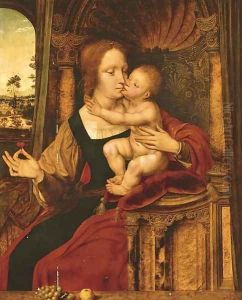Quinten Massys Paintings
Quinten Massys, also known as Quentin Matsys, Quinten Metsys, or Quinten Messys, was a Flemish painter in the early Renaissance period, born in 1466 in the city of Leuven, which was then part of the duchy of Brabant (now in modern-day Belgium). Massys is often regarded as the founder of the Antwerp school of painting. His work is characterized by its meticulous technique, humanist concerns, and its use of emotional expression and symbolism. He is particularly known for his detailed portrayal of human figures and his contribution to the development of Northern Renaissance art.
Massys began his career as a blacksmith and metalworker, which was his father's trade. However, his life took a turn towards art when, according to Karel van Mander's 16th-century biography of artists, he fell in love with an artist's daughter and decided to study painting to win her affection. Whether this romantic story is true or not, it is clear that Massys was an exceptionally skilled artist who was active in Antwerp by 1491, when he became a master in the Guild of Saint Luke, the city's painters' guild.
His early works show a strong influence from the older generation of Flemish artists, like Dirk Bouts and Hans Memling, but Massys soon developed his own distinctive style. His religious works, such as the 'Enthroned Madonna' and 'The Lamentation', are noted for their piety and emotional depth. Massys was also one of the first Flemish artists to incorporate Italian Renaissance influences, such as linear perspective and elements of classicism, into his work, which can be seen in his painting 'Saint Anna Altarpiece'.
In addition to religious subjects, Massys had a keen interest in human character and painted remarkable portraits and genre scenes. His two most famous genre paintings, 'The Moneylender and his Wife' and 'The Ugly Duchess', reflect his interest in human physiognomy and social commentary. These works also display his skill in rendering textures and surfaces, a legacy of his early training as a metalworker.
Massys' work was highly influential in his time and continued to be celebrated after his death in 1530. He had many students and followers, including his sons Jan and Cornelis Massys, who also became painters. His legacy was carried on through the Antwerp school, which would later include artists such as Peter Paul Rubens. Massys' paintings can be found in major museum collections across the world, securing his place as an important figure in the history of Northern Renaissance art.


